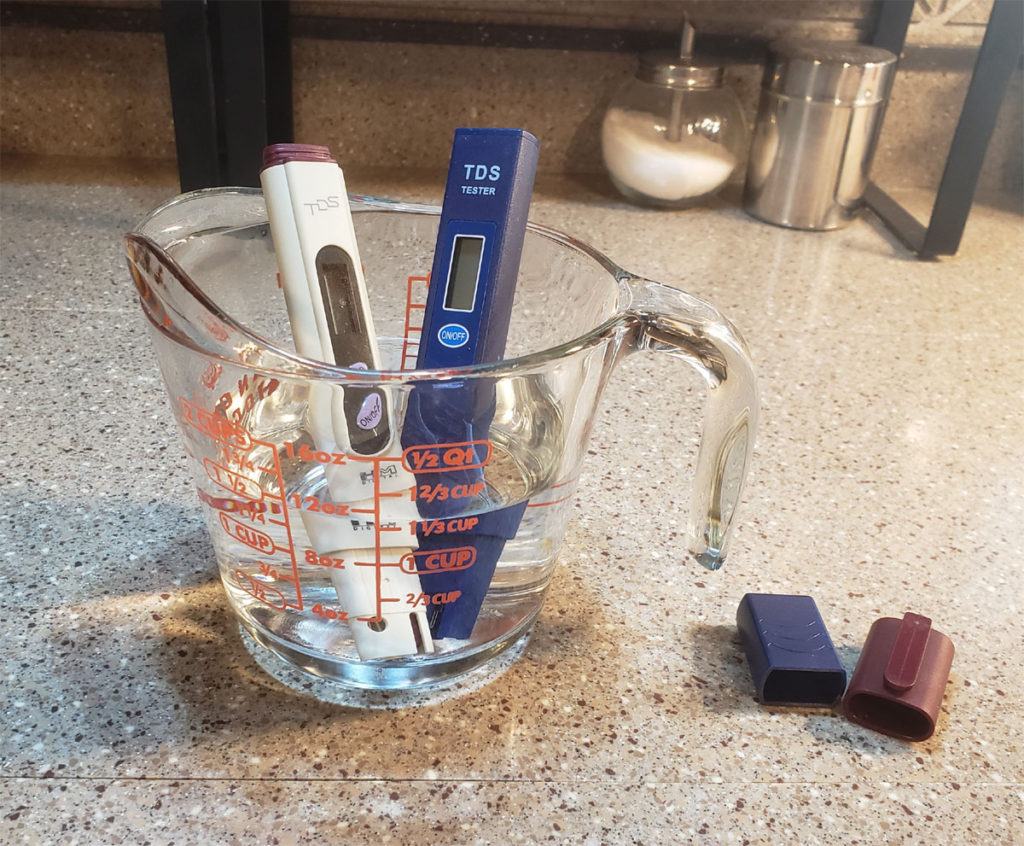In our travels, we’ve lived in areas with less than desirable drinking water. We’ve reduced some of the hard water contaminates by using a slew of water filters, inside and outside our motorcoach. As we migrate, we constantly monitor the water quality in each park we stay in.
Assessing its quality
Prior to leaving for Mexico, we purchased two different water quality testers to check the saturation level of solids in ground water. Why two? For redundancy, so each would corroborate the other.

Water regulations
Federal water regulations state that safe (or marginal) drinking water is between zero ppm (parts per million) and 500 ppm of solids suspended in water. Our first test was in Puerto Penasco, Sonora, Mexico, where the water was 170 ppm. Better than we expected, as years ago the saying was, “When in Mexico, don’t drink the water!” While in Puerto Penasco, we purchased a case of bottled water and 2.5-gallon jugs of water at their Sam’s Club for daily coffee and consumption. That water averaged 15 ppm. Quite sufficient.

Coming back to the states
When our time was up in Mexico, we departed for Apache Junction, Arizona. The first morning, we tested the ground water out of the faucet. The water out of the tap was reading 874 ppm on one tester and 871 on the other! Startling! And we thought Mexico was bad? To quell our drinking water dilemma, we refilled our jugs at a Reverse Osmosis (R/O) water dispensing location. This water averaged 15 ppm on both testers. As a comparison, we ran the faucet water for one minute and again tested the ground water from the park using one filter at 100 microns and one filter at 10 microns. It still registered 675 ppm. Hmmm! What’s in this water? Is the city doing anything to this water?
Discussed this issue
My hubby discussed R/O systems with local plumbers. The outcome advice was to purchase a tankless unit with the new leakless fittings. So, hubby began researching and found a compact, tankless R/O system online. Before purchasing the system, Waterdrop, he discussed this R/O system directly with the manufacturer. Normally, he would hire a plumber to install, as he has always said he will not hang wallpaper or do plumbing jobs in tight spaces where it hurts his back, making him grouchy!
Waterdrop arrived
After reading the instructions, hubby laid on a pillow hooking up the lines to the water pipes. All I did was hand him tools when needed, and, in just over one hour, the tankless R/O system was installed. The R/O system took far less space than we appropriated, fittings were easy to use and no specialty tools were needed to attach to the unit. The tools used were two crescent wrenches, 1/4” drill bit and electric drill, and a Phillips #2 screwdriver. Everything needed was in the box, including plumbers’ Teflon tape.

He plugged the Waterdrop electric cord into the dishwasher outlet and voila, we should have good water. Nose level smell… none! No leaking! Hubby opened the new faucet, letting it run for at least one minute before filling a clean cup with water for testing. The first test read 104 ppm. Not satisfied, hubby asked me to open the faucet and let it run for two more minutes. Our second test read “0” ppm! Problem solved.
Now the lugging of large jugs of water in and out or having empty plastic water bottles around are a distant memory. And our morning coffee is delightful!
You can find Waterdrops products on Amazon, or on their website.
You can find water testing meters on Amazon here: https://affiliate-program.amazon.com/home/productlinks/customize?asin=B079DN9DRS#:~:text=%3Ciframe%20style%3D%22width,bg_color%3Dffffff%22%3E%0A%20%20%20%20%3C/iframe%3E
Kate Doherty has been writing for more than 30 years in technical and general media. In her previous business, she and her spouse dealt with special projects within the military/government sector. Recently she published Masquerade: A Logan Scott Novel under the pen name Bryan Alexander, a thriller now available in eBook and paperback on Amazon. It’s a page-turner!